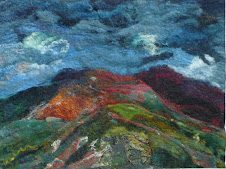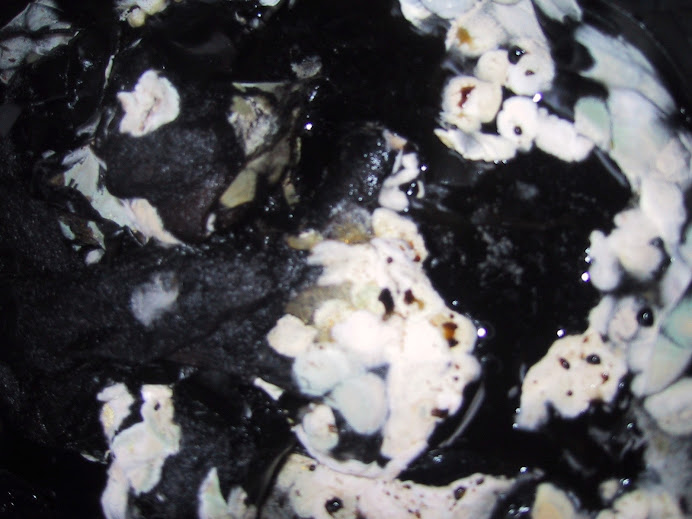
 Picture above "Seascape" is painted with natural dyes with pastels over the top. And some samples of painting with natural dyes
Picture above "Seascape" is painted with natural dyes with pastels over the top. And some samples of painting with natural dyesI always find that the period between the end of Christmas and the start of the new year is the time for a bit of play and this year two projects have started growing in my mind and giving me something to look forward to after Christmas when I have a tendency to slide into post Christmas blues.
Natural Dyes as Inks
One project has been triggered by a fairly casual remark but has set off a train of thought. Last week I went to visit the studio of a local artist I met recently who paints vibrant and vivid landscapes of the Welsh countryside-his name is David Brightmore - and his work can be seen ( if the new website is up) at http://www.davidbrightmore.com/. David showed how he works and paints using acrylic inks over shapes and pieces which he then peels off to reveal textured and patterned surface which he then works into further. I mentioned as we were chatting that I paint with natural dyes, which I initially learnt to do at Colour Congess but I have been working on it ever since. David said "could you make me up some natural dye inks in primary colours"? My first reaction was well natural dyes don't work like that colour wise , and in any case they tend to go off and smell. This is because I am a bit of a slob and leave the dye materials in which in the course of time go off. Cochineal is the worse for this as the smell is really dreadful after a couple of weeks. Then I got to thinking as, as so often happens, I walk the dogs in the hills. Firstly on the colour problem. Cochineal with tin will give reds, bright yellow I am hoping to get from black oak bark - I have some in soak now, because dyes like weld go greenish when painted onto paper and saffron , absolutely gorgeous as a paint, is on the orange side. Blue is the most difficult as I paint with an indigo concentrate and as David knows nothing about dyes I don't suppose he would appreciate having to keep it in a reduced state. I am wondering whether I can use Indigo sulphonate of which I have some ( made from indigo and sulphuric acid) or from logwood with woodash lye which in my water gives a blue, but a dark blue. You can see how fascinated I have become. Then I mentioned to a friend , Debbie the Mulberry Dyer http://www.mulberrydyer.co.uk/ who is very knowledgeable about historical dyes who told me she has a recipe for a medieval ink. I wonder what the definition of an ink is?
Filtering baths to create inks
On the problem of smelly baths suppose I filter the baths ? At the moment I have very concentrated baths in jam jars in my slow cookers where they have been for twenty four hours hopefully the continuous but gentle heat will extract the dyes. I almost never boil natural dyes as this dulls most colours. If you are wondering why I am not using extract dyes for this-well I could but as you need very concentrated dye liqours using extract dyes is an expensive way to do this. Furthermore extract dye do not respond to colour modification such as with copper and tin as well as do dye baths made direct from plant materials.
As I make my marzipan icing -yes late I know but I do have to drag myself in from felting/dyeing to cook-I find my self turning the problems over in my mind and and I think that I will do some research into ancient and medieval inks.
Second project?
Well that is a felting one and I think I will keep it for another day
As I make my marzipan icing -yes late I know but I do have to drag myself in from felting/dyeing to cook-I find my self turning the problems over in my mind and and I think that I will do some research into ancient and medieval inks.
Second project?
Well that is a felting one and I think I will keep it for another day
Update on the hunt for black
I met someone yesterday w ho has givien the phone number of someone who will be cutting the alders by the riverbanks in North Wales. He thinks they might be prepared to let me chip off some bark for black. He also told me ( having spent a life time working with trees that when you cut alder it is white but goes orange in the air. hmm!
I was told by a friend that this blog was nice but very technical and only for the serious dyer! :( - Oh well it keeps me happy!




























I like your blog very much, but maybe I belong to the serious dyer-group:-)
ReplyDeleteMedieval inks are new to me and I am looking forward to reading how you make them, sounds like something that would be fun to try.
Another thing that you wrote today is that you almost never boil the dyestuffs, and I haven't thought about it very much before, just sometimes boiled and sometimes not, but you gave me something to think about seriously, I am sure you are right not to boil!
I agree that alder bark turns orange and if you peel it with your bare hands from the trees, your nails get all orange!
I agree with Leena - but I suppose I am serious about dyeing too:)) there are many blogs about "dyeing", where you only find the diddledidah without proper information, so please keep the "technical" stuff going!
ReplyDeletethe colour you received with the buckthorn buck is absolutely stunning! pity, that our trees are still to small to steal some of their bark - my DH would murder me if I did!
you write about heat pads, what kind of pad is that? I use the electrical canning kettle I "inherited", filled with water and small glass jars, and I know the single or double cooking plates, but not heat pads!
the scarf turned out lovely too, I will try this out after christmas, albeit with normal dyed merino... have a good time and I hope you don't have any more near-katastrophes to escape from!
Hi I think we msut all be serious dyers :)
ReplyDeleteWith regard to the boiling generally speaking I find the colours are clearer if not boiled. Although there are always exceptions to this rule
The heat pads are ones used for wine making. Whne I was researching into fermented indigo vats a friend who used to make wine gave then to me and they have been fantastic